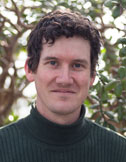Alastair Simpson
 |
PROFESSOR BSc (Sydney, 1994) PhD (Sydney, 2000) |
|||
| Teaching & Research origin and early evolution of eukaryotes, Protistan biodiversity, phylogenetics and systematics, Protistan ultrastructure, and molecular evolution
|
||||
Hess S., Eme L., Roger A.J. & Simpson A.G.B. (2019) A natural toroidal microswimmer with a rotary eukaryotic flagellum. Nature Microbiology. doi: 10.1038/s41564-019-0478-6
Lax G., Lee W.J., Eglit Y. & Simpson A.G.B. (2019) Ploeotids represent much of the phylogenetic diversity of euglenids. Protist, 170, 233-257.
Lax G.*, Eglit Y.*, Eme L.*, Bertrand E. Roger A.J. & Simpson A.G.B (2018) Hemimastigophora is a novel supra-kingdom-level lineage of eukaryotes. Nature, 564, 410-414.
Goodwin J.D., Lee T.F., Kugrens P. & Simpson A.G.B. (2018) Allobodo chlorophagus n. gen n. sp, a kinetoplastid that infiltrates and feeds on the invasive alga Codium fragile. Protist, 169, 911-925.
Buchwald R., Scheibling R.E., & Simpson A.G.B. (2018) Detection and quantification of a keystone pathogen in a coastal marine ecosystem. Marine Ecology Progress Series 606, 79-90.
Heiss, A.A., Kolisko, M., Ekelund, F., Brown M.W., Roger, A.J., Simpson, A.G.B. 2018. Combined morphological and phylogenomic re-examination of malawimonads, a critical taxon for inferring the evolutionary history of eukaryotes. Royal Society Open Science, 10: 171707.
Brown, M.W., Heiss, A.A., Kamikawa, R., Inagaki, Y., Yabuki, A., Tice, A. K., Shiratori, T., Ishida, K., Hashimoto, T., Simpson, A.G.B., Roger, A.J. 2018. Phylogenomics places orphan protistan lineages as deep sisters to Amorphea and identifies a novel eukaryotic super-group. Genome Biology and Evolution, 10: 427-433.
Harding, T. & Simpson, A.G.B. 2018. Recent advances in halophilic protozoa research. Journal of Eukaryotic Microbiology, in press.
Archibald, J.M., Simpson, A.G.B. & Slamovits C. (eds.) 2017. Handbook of the Protists, 2nd edition. Springer. 1657 pp.
Yang, J., Harding, T., Kamikawa, R., Simpson, A.G.B. & Roger A.J. 2017. Mitochondrial genome evolution and a novel RNA editing system in deep-branching heteroloboseids. Genome Biology and Evolution 9: 1161-1174.
Harding, T., Roger, A.J. & Simpson, A.G.B. 2017. Adaptations to high salt in a halophilic protist: Differential expression and gene acquisitions through duplications and gene transfers. Frontiers in Microbiology 8: 944.
Leger, M.M., Kolisko, M., Kamikawa, R., Stairs, C.W., Kume, K., Čepicka, I., Silberman, J.D., Andersson, J.O., Xu, F. Yabuki, A., Eme, L., Zhang, Q., Takishita, K., Inagaki, Y., Simpson, A.G.B., Hashimoto, T. & Roger, A.J. 2017. Organelles that illuminate the origins of Trichomonas hydrogenosomes and Giardia mitosomes. Nature Ecology and Evolution 1: 0092.
Harding, T., Brown, M., Simpson, A.G.B. & Roger, A.J. 2016. Osmoadaptive strategy and its molecular signature in obligately halophilic heterotrophic protists. Genome Biology and Evolution 8: 2241-2258.
Zhang, Q., Táborský, P., Silberman, J.D., Pánek, T., Čepička, I. & Simpson, A.G.B. 2015. Marine isolates of Trimastix marina form a plesiomorphic deep-branching lineage within Preaxostyla, separate from other known trimastigids (Paratrimastix n. gen.). Protist 166: 468-491
Park, J.S. & Simpson, A.G.B. 2015. Diversity of heterotrophic protists from extremely hypersaline habitats. Protist, 166: 422-437.
Buchwald, R.T., Feehan, C.J., Scheibling, R.E. & Simpson, A.G.B. 2015. Low temperature tolerance of a sea urchin pathogen: implications for benthic community dynamics in a warming ocean. Journal of Experimental Marine Biology and Ecology, 469: 1-9.
Kirby, W.A., Tikhonenkov, D.V., Mylnikov, A.P., Janouškovec, J., Lax, G., & Simpson, A.G.B. 2015. Characterisation of Tulamoeba bucina n. sp., an extremely halotolerant amoeboflagellate heterolobosean belonging to the Tulamoeba-Pleurostomum clade (Tulamoebidae n. fam.). Journal of Eukaryotic Microbiology, 62: 227-238.
Lax, G. & Simpson, A.G.B. 2013. Combining molecular data with classical morphology for uncultured phagotrophic euglenids (Excavata); A single-cell approach. Journal of Eukaryotic Microbiology, 60: 615-625.
Brown, M.W., Sharpe, S.C., Silberman, J.D., Heiss, A.A., Lang, B.F., Simpson, A.G.B. & Roger, A.J. 2013. Phylogenomics demonstrates that breviate flagellates are related to opisthokonts and apusomonads. Proceedings of the Royal Society, series B 280: 20131755.
Heiss, A.A., Walker, G. & Simpson, A.G.B. 2013. The microtubular cytoskeleton of the apusomonad Thecamonas, a sister lineage to the opisthokonts. Protist, 164: 598–621.
Heiss, A.A., Walker, G. & Simpson, A.G.B. 2013. The flagellar apparatus of Breviata anathema, a eukaryote without a clear supergroup affinity. European Journal of Protistology, 49: 354-372.
Feehan, C.J., Johnson-Mackinnon, J., Scheibling, R.E., Lauzon-Guay, J.-S. & Simpson A.G.B. 2013. Validating the identity of Paramoeba invadens, the causative agent of recurrent mass mortality of sea urchins in Nova Scotia. Diseases of Aquatic Organisms, 103: 209-227.
Adl, S.M., Simpson, A.G.B., & 23 others 2012. The revised classification of eukaryotes. Journal of Eukaryotic Microbiology, 59: 429-514.
Zhang, Q., Simpson, A.G.B. & Song, W. 2012. Insights into the phylogeny of systematically controversial haptorian ciliates (Ciliophora, Litostomatea) based on multigene analyses. Proceedings of the Royal Society, series B., 279: 2625-2635.
Takishita, K., Kolisko, M., Komatsuzaki, H., Yabuki, A., Inagaki, Y., Čepička, I., Smejkalová, P., Silberman, J.D., Hashimoto, T., Roger, A.J. & Simpson, A.G.B. 2012. Multigene phylogenies of diverse Carpediemonas-like organisms identify the closest relatives of ‘amitochondriate’ diplomonads and retortamonads. Protist, 163: 344-355.
Park, J.S. & Simpson A.G.B. 2011. Characterization of Pharyngomonas kirbyi (= “Macropharyngomonas halophila” nomen nudum), a very deep-branching, obligately halophilic heterolobosean flagellate. Protist, 162: 691-709.
Mora, C., Tittensor, D.P., Adl, S., Simpson A.G.B., Worm, B. 2011. How many species are there on Earth and in the Ocean? PLoS Biology 9: e1001127.
Heiss, A.A., Walker, G. & Simpson A.G.B. 2011. The ultrastructure of Ancyromonas, a eukaryote without supergroup affinities. Protist, 162: 373-393.
Kolisko, M., Silberman, J.D., Čepička, I., Yubuki, N., Takishita, K., Yabuki, A., Leander, B.S., Inouye, I., Inagaki, Y., Roger, A.J. & Simpson, A.G.B. 2010. A wide diversity of previously undetected relatives of diplomonads isolated from marine/saline habitats. Environmental Microbiology, 12: 2700-2710.
Park, J.S. & Simpson, A.G.B. 2010. Characterisation of halotolerant Bicosoecida and Placididea (Stramenopila) that are distinct from marine forms, and the phylogenetic pattern of salinity preference in heterotrophic stramenopiles. Environmental Microbiology, 12: 1173-1184.
Hampl, V., Hug, L., Leigh, J., Dacks, J.B., Lang, B.F., Simpson, A.G.B. & Roger, A.J. 2009. Phylogenomic analyses support the monophyly of Excavata and robustly resolve relationships among eukaryotic “supergroups”. Proceedings of the National Academy of Sciences USA, 106, 3859-64.
Roger, A.J. & Simpson, A.G.B. 2009. Evolution: Revisiting the Root of the Eukaryote Tree. Current Biology, 19, R165-167.
Park, J.S., Simpson, A.G.B., Brown, S. & Cho B.C. 2009. Ultrastructure and molecular phylogeny of two heterolobosean amoebae, Euplaesiobystra hypersalinica gen. et sp. nov. and Tulamoeba peronaphora gen. et sp. nov., isolated from an extremely hypersaline habitat. Protist, 160, 265-283.
Simpson, A.G.B., Perley,T. & Lara, E. (2008) Lateral transfer of the gene for a widely used marker, alpha tubulin, indicated by a multi-protein study of the phylogenetic position of Andalucia (Excavata). Molecular Phylogenetics and Evolution, 47, 366-377.
Park, J.S., Simpson, A.G.B., Lee, W.J. & Cho, B.C. 2007. Ultrastructure and phylogenetic placement within Heterolobosea of the previously unclassified, extremely halophilic heterotrophic flagellate Pleurostomum flabellatum (Ruinen 1938). Protist, 158, 397-413.
Park J.S., Cho B.C., and Simpson, A.G.B. 2006. Halocafeteria seosinensis gen et sp. nov. (Bicosoecida), a halophilic bacterivorous nanoflagellate isolated from a solar saltern. Extremophiles, 10, 493-504.
Simpson, A.G.B., Stevens, J.R. & Lukes J. 2006. The evolution and diversity of kinetoplastid flagellates. Trends in Parasitology, 22, 168-174.
Simpson, A.G.B., Inagaki, Y. & Roger, A.J. 2006. Comprehensive multi-gene phylogenies of excavate protists reveal the evolutionary positions of 'primitive' eukaryotes. Molecular Biology and Evolution, 23, 615-625.
Adl, S.M., Simpson, A.G.B., Farmer, M., & 25 others 2005.The new higher-level classification of eukaryotes with emphasis on the taxonomy of protists. Journal of Eukaryotic Microbiology, 52, 399-451.
Simpson A.G.B., Gill E.E., Callahan H.A., Litaker R.W. & Roger A.J. 2004. Early evolution within kinetoplastids (Euglenozoa), and the late emergence of trypanosomatids. Protist 155, 407-422.
Simpson, A.G.B. & Roger, A.J. 2004.The real 'kingdoms' of eukaryotes. Current Biology 14, R693-696.
Simpson A.G.B. & Roger A.J. 2004. Protein phylogenies robustly resolve the deep-level relationships within Euglenozoa. Molecular Phylogenetics and Evolution, 30: 201-212.
Simpson A.G.B. 2003. Cytoskeletal organisation, phylogenetic affinities and systematics in the contentious taxon Excavata (Eukaryota). International Journal of Systematic and Evolutionary Microbiology, 53: 1759-1777.
Simpson A.G.B., Lukes J. & Roger A.J. 2002. Evolutionary history of kinetoplastids, and their kinetoplasts. Molecular Biology and Evolution 19: 2071-2083.
Simpson A.G.B., and Roger A.J. 2002. Eukaryotic evolution: Getting to the root of the problem. Current Biology, 12: 691-693.
Simpson A.G.B., MacQuarrie E.K., & Roger A.J. 2002. Early evolution of canonical introns. Nature 419: 270.
Simpson A.G.B., Roger A.J., Silberman J.D., Leipe, D.D., Edgcomb V.P., Jermiin, L.S., Patterson, D.J. & Sogin M.L. 2002. Evolutionary history of 'early diverging' eukaryotes: The excavate taxon Carpediemonas is a close relative of Giardia. Molecular Biology and Evolution 19: 1782-1791.
Simpson A.G.B. & Patterson, D.J. 1999. The ultrastructure of Carpediemonas membranifera: (Eukaryota), with reference to the 'excavate hypothesis'. European Journal of Protistology 35: 353-370.
Simpson A.G.B. 1997. The identity and composition of the Euglenozoa. Archiv für Protistenkunde 148: 318-328.

 was born, raised and educated in Sydney, Australia. I finished a PhD in Biology at the University of Sydney in 2000, having also spent several months at the Marine Biology Laboratory at Woods Hole (USA). I came to Dalhousie University in 2000 as a postdoctoral fellow in the Biochemistry Department, and joined the Biology Faculty in July 2003.
was born, raised and educated in Sydney, Australia. I finished a PhD in Biology at the University of Sydney in 2000, having also spent several months at the Marine Biology Laboratory at Woods Hole (USA). I came to Dalhousie University in 2000 as a postdoctoral fellow in the Biochemistry Department, and joined the Biology Faculty in July 2003.